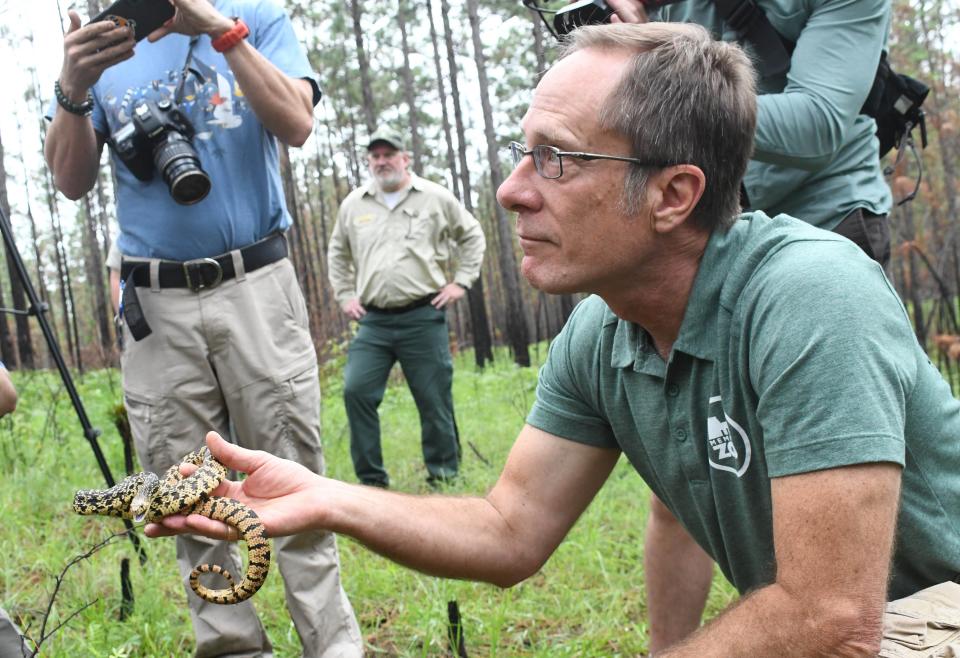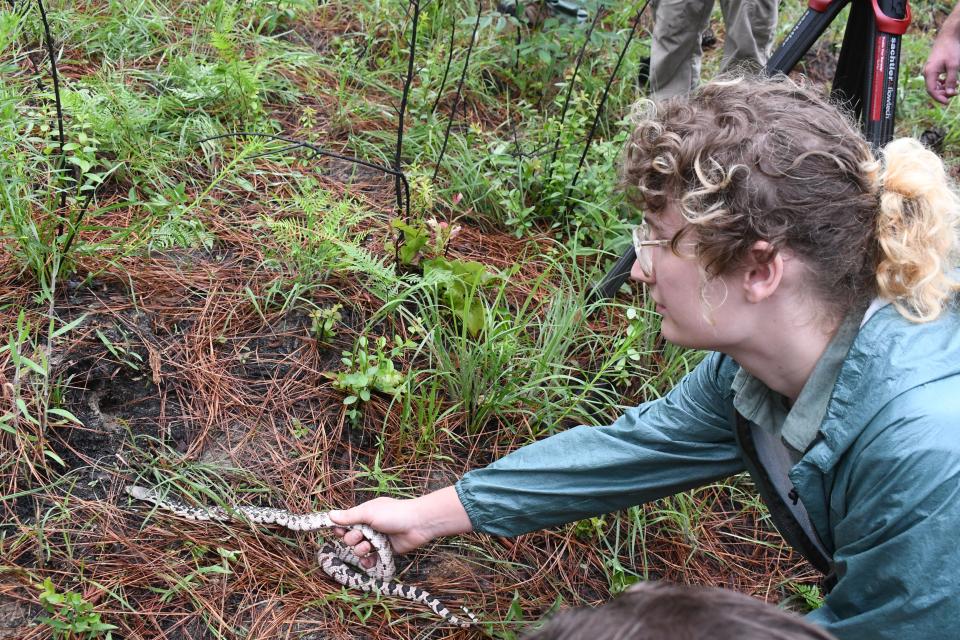Biologists help Louisiana pine snakes thrive in Kisatchie National Forest
KISATCHIE NATIONAL FOREST – Many eyes were on the endangered Louisiana pine snake as it hissed and rattled its tail defensively outside the pocket gopher burrow where it was released.
The behavior is typical for these kinds of snakes when it feels threatened, said Dr. Steve Reichling, director of conservation and research at the Memphis Zoo in Tennessee. They are non-venomous and though defensive against would-be predators, are not considered aggressive.
“They’re rough and they’re tough. It’s a rough life out here with the hawks and the pocket gophers which they feed on which are tough customers themselves. These snakes are products of their environment,” said Reichling.

People might encounter them in their yards or gardens and this behavior doesn’t win these endangered snakes any friends. Unfortunately, their defensive behavior often gets them killed, Reichling.
Since they are federally protected, it is illegal to harm, harass or collect these snakes.
For the past week, wildlife biologists have been reintroducing Louisiana pine snakes into Kisatchie National Forest to increase the population. A press release handed out by the U.S. Forest Service says the Louisiana pine snakes are a threatened species and considered one of the rarest snakes in North America.
The release sites are not made public to keep those who want to harm or collect them from doing so.
Kisatchie National Forest has open pine forest with grassy understory that is a suitable habitat for these rare snakes. The U.S. Forest Service regularly conducts prescribed burns to maintain the forest otherwise these rare snakes wouldn't be able to survive.
In 2010, The U.S. Forest Service along with the Southern Research Station, the Louisiana Department of Wildlife and Fisheries and the Memphis Zoo, Fort Worth Zoo, Lufkin Zoo and the Audubon Zoo have collaborated to increase the pine snakes’ population. The snakes were bred at the zoos which produce about 150 snakes a year.

The area in the forest selected for the snakes’ release is based on suitability of the soil, said Emlyn B. Smith, Catahoula Ranger District biologist for the U.S. Forest Service.
“Then we come out and find pocket gophers,” said Smith, which are what the snakes primarily eat.
They also eat other rodents, cottontails, amphibians and ground nesting birds and eggs, according to a handout given out by the U.S. Forest Service. They play an important part in the ecosystem.
“That’s the key. We find the pocket gophers then we know it’s a suitable habitat for them because that’s where they need to live, in the tunnels,” she said.
The holes are chosen based on how comfortable the snakes can go in, said Cassie Collins, research husbandry technician at the Memphis Zoo.
If the soil loose, the snakes can dig their way in, said Smith. The snakes have scales on their nose that they can use to burrow in, added Collins.
The snakes have what are called PIT tags in them for which the zoos can collect data.
“We give them tags right under their scales and we can read them with special tag readers. That helps us make sure we have the identity of the exact snake that we’re looking for,” said Collins.
There are PIT tag readers all around the habitat that help them detect to see if a certain snake is still alive months or years after they are released.
Smith said that they have an 11-year-old snake that they have tagged.
Louisiana Pine Snakes have been released every year since 2010, said Smith.
She monitors snake traps as well as the pit reader to see how the snakes are doing.
“We think there’s 107 out here,” Smith said about this area of Kisatchie. That’s based on population modeling.
They know that the snakes have been reproducing since they found snakes without PIT tags.
“We caught five juvenile snakes that are not PIT tagged and so we PIT tagged them and we can track them in their future,” she said.
They released some snakes in 2019 and caught one of the four-year-old babies from that group in a trap.
“We have DNA for every zoo snake and DNA for every snake that’s been released out here. So the very first snake that we caught out here that was not tagged, they did the DNA to find the parentage on it and it was zoo bred,” she said.
That was a great success for them. For her, it was exciting to find the offspring of those snakes.
The Louisiana pine snakes are species-specific, meaning that they don’t cross-breed with other species of snakes, said Stacy Blomquist, public affair specialist for the U.S. Forest Service.
Louisiana pine snakes start to reproduce at 3-4 years old, said Beth Roberts, senior conservation scientist at the Memphis Zoo. They grow slow and reproduce slowly, she added.
“One of the things about pine snakes that’s so special and unique is they have low fecundity,” said Roberts, meaning how many offspring or eggs they are physically able to produce. “They have one of the lowest fecundities for body size of all North American snakes.”
Rat snakes can make clutches, or groups of eggs, of about 20-30 while pine snakes have clutches of about 4-6 she said. They only breed once a year.
Pine snakes also have one of the largest egg sizes at around 5 inches and are about a foot long once they hatch.
“They make really big eggs but they don’t make a lot of them so they can have big babies,” she said.
This article originally appeared on Alexandria Town Talk: Biologists help Louisiana pine snakes thrive in Kisatchie Forest

